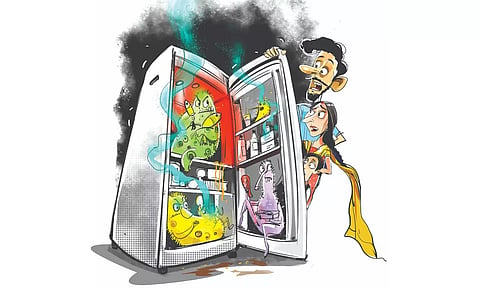

CHENNAI: Whether it’s your daily meal or something extraordinary prepared for guests, there’s always the possibility of having leftovers. While it’s a common practice to store food in refrigerators, the lifespan of the leftovers is unknown.
The food prepared for breakfast is often kept outside till lunch. Sometimes, people tend to store food inside the fridge and reheat it to consume later.
However, experts and dieticians in the city say that consumption of stored food – whether cooked at home or made at hotels — can lead to food poisoning and other infections.
Bacterial growth
Leftovers stored inside the refrigerator must be consumed in 3-4 days. If that’s not possible, it’s safer to discard the dish, as it can contain various microbial germs that are invisible to the naked eye.
Ashwin Bhadri, CEO of Equinox Labs, a food, water and air testing laboratory, says, “The bacteria will neither change the colour of your food nor the smell and taste, but it will surely be present in your food after 3-4 days. It can cause food poisoning and other illnesses such as salmonella, hepatitis a, norovirus, among others.”
To retain the quality of food, it must be kept inside the fridge immediately after consumption. Do not keep it outside for over 2 hours.
“It’s advisable to keep the food outside only for an hour if the temperature is above 90 degrees Fahrenheit. The best way to store your food is to keep it outside the ‘danger zone’ – from 40-degree F to 140-degree F. Below and above the stated temperatures are chances for bacteria to multiply faster. The key point here is to keep ‘hot food hot’ and ‘cold food cold’,” adds Ashwin.
For instance, biriyani must be kept on the stove until you sit for lunch. Similarly, chicken salads or meat sandwiches should not be kept outside. Store them in the fridge.
Store it right
When we buy food from outside, most of us store the leftovers in the fridge. Though it feels like the dish is fresh after re-heating, the unknown storage condition of the food before it was delivered to us makes its quality questionable.
The high temperatures also prevent the bacteria from showing any change of taste or smell in the food but can adversely impact our health in different ways.
S Chandrakala Rajkumar, clinical nutritionist and dietician at Women’s Centre by Motherhood Hospital, says, “Food from a restaurant or a dish bought online can get spoiled when refrigerated again and again. Staphylococcus aureus bacteria creates toxins. When we re-cook the dish, these bacteria will be destroyed but toxin will remain.”
Experts opine that the majority of the Indian dishes have fibres, salt and sour elements that act as natural preservative elements. In such conditions, microbes cannot survive. However, it’s advisable to use refrigerators for storage.
Moreover, it’s important to clean the fridge regularly and to maintain the temperature between 35-40 degrees. If the temperature exceeds, bacterial growth increases. “In case of frozen foods including non-veg food items, they can be stored for a maximum of 1 week,” she adds.
Plan for no wastage
While it’s important that food is stored right and consumed after being heated and frozen properly, wastage has also been flagged as a concern. Proper planning while cooking is emphasized by the doctors.
Nutritionists advise against overloading refrigerators with food because moisturisation increases due to the circulating cold air inside the fridge. This results in infection, resulting in the growth of bacteria and fungus. Mahalakshmi, assistant manager at the department of nutrition & dietetics, Dr Mohan’s Diabetes Specialist Centre, says that all perishable food items need to be kept in the fridge within 1 hour after it’s bought from the market.
“In South Indian households, our staple food is rice. Cooked rice must be consumed the same day. If consumed the next day, add water in it and consume it as kanji,” states Mahalakshmi. “The food should be stored in airtight containers even if it’s in the fridge. Non-vegetarian food should be wrapped in a foil and used up in 2-3 days. If it’s consumed after 3 days, it should be stored in the freezer and not be left open for 1-2 hours.”
The manner in which the leftovers are treated is also an important factor. Do not open the fridge frequently because the fluctuations of the temperature can spoil the food. Buy smaller quantities of food. This can prevent left-overs, and thereby prevent reheating and refrigeration.
Experts also emphasise that following proper food hygiene. It’s important to remember the appropriate temperatures while heating or freezing foods. Plan and prepare ahead – it would go a long way into retaining the nutritional value of the food products.
In a nutshell